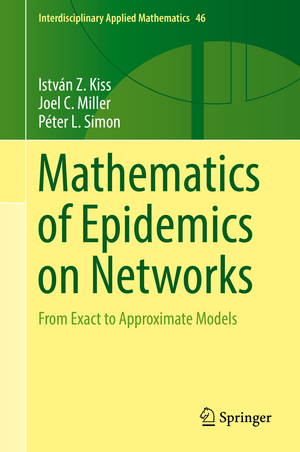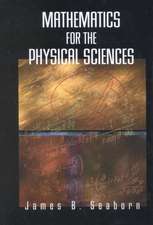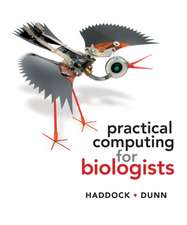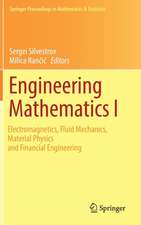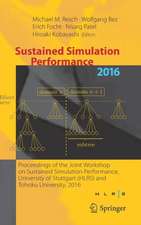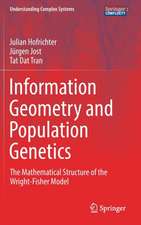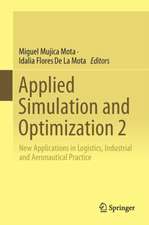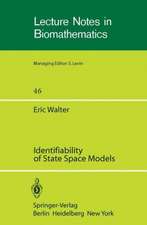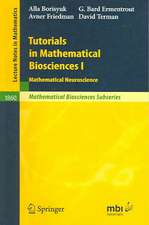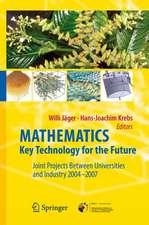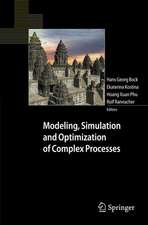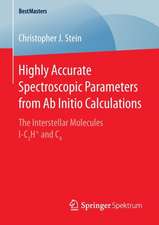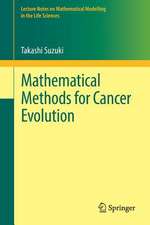Mathematics of Epidemics on Networks: From Exact to Approximate Models: Interdisciplinary Applied Mathematics, cartea 46
Autor István Z. Kiss, Joel C. Miller, Péter L. Simonen Limba Engleză Hardback – 22 mai 2017
This textbook provides an exciting new addition to the area of network science featuring a stronger and more methodical link of models to their mathematical origin and explains how these relate to each other with special focus on epidemic spread on networks. The content of the book is at the interface of graph theory, stochastic processes and dynamical systems. The authors set out to make a significant contribution to closing the gap between model development and the supporting mathematics. This is done by:
- Summarising and presenting the state-of-the-art in modeling epidemics on networks with results and readily usable models signposted throughout the book;
- Presenting different mathematical approaches to formulate exact and solvable models;
- Identifying the concrete links between approximate models and their rigorous mathematical representation;
- Presenting a model hierarchy and clearly highlighting the links between model assumptions and model complexity;
- Providing a reference source for advanced undergraduate students, as well as doctoral students, postdoctoral researchers and academic experts who are engaged in modeling stochastic processes on networks;
- Providing software that can solve differential equation models or directly simulate epidemics on networks.
Replete with numerous diagrams, examples, instructive exercises, and online access to simulation algorithms and readily usable code, this book will appeal to a wide spectrum of readers from different backgrounds and academic levels. Appropriate for students with or without a strong background in mathematics, this textbook can form the basis of an advanced undergraduate or graduate course in both mathematics and other departments alike.
| Toate formatele și edițiile | Preț | Express |
|---|---|---|
| Paperback (1) | 495.62 lei 6-8 săpt. | |
| Springer International Publishing – 28 iul 2018 | 495.62 lei 6-8 săpt. | |
| Hardback (1) | 528.45 lei 3-5 săpt. | +38.73 lei 4-10 zile |
| Springer International Publishing – 22 mai 2017 | 528.45 lei 3-5 săpt. | +38.73 lei 4-10 zile |
Din seria Interdisciplinary Applied Mathematics
- 19%
 Preț: 420.88 lei
Preț: 420.88 lei - 15%
 Preț: 667.05 lei
Preț: 667.05 lei - 20%
 Preț: 664.77 lei
Preț: 664.77 lei - 15%
 Preț: 980.97 lei
Preț: 980.97 lei - 9%
 Preț: 630.35 lei
Preț: 630.35 lei - 18%
 Preț: 908.71 lei
Preț: 908.71 lei - 18%
 Preț: 1006.38 lei
Preț: 1006.38 lei - 15%
 Preț: 659.67 lei
Preț: 659.67 lei -
 Preț: 498.14 lei
Preț: 498.14 lei -
 Preț: 528.35 lei
Preț: 528.35 lei - 15%
 Preț: 659.02 lei
Preț: 659.02 lei - 15%
 Preț: 480.52 lei
Preț: 480.52 lei -
 Preț: 390.63 lei
Preț: 390.63 lei - 18%
 Preț: 918.61 lei
Preț: 918.61 lei -
 Preț: 388.52 lei
Preț: 388.52 lei - 15%
 Preț: 647.92 lei
Preț: 647.92 lei - 15%
 Preț: 655.60 lei
Preț: 655.60 lei - 23%
 Preț: 734.81 lei
Preț: 734.81 lei - 15%
 Preț: 660.83 lei
Preț: 660.83 lei - 18%
 Preț: 967.08 lei
Preț: 967.08 lei -
 Preț: 809.10 lei
Preț: 809.10 lei -
 Preț: 403.91 lei
Preț: 403.91 lei - 18%
 Preț: 896.84 lei
Preț: 896.84 lei - 18%
 Preț: 1004.00 lei
Preț: 1004.00 lei - 18%
 Preț: 974.19 lei
Preț: 974.19 lei -
 Preț: 399.67 lei
Preț: 399.67 lei - 23%
 Preț: 639.30 lei
Preț: 639.30 lei
Preț: 528.45 lei
Preț vechi: 636.69 lei
-17% Nou
Puncte Express: 793
Preț estimativ în valută:
101.13€ • 105.19$ • 83.49£
101.13€ • 105.19$ • 83.49£
Carte disponibilă
Livrare economică 24 martie-07 aprilie
Livrare express 07-13 martie pentru 48.72 lei
Preluare comenzi: 021 569.72.76
Specificații
ISBN-13: 9783319508047
ISBN-10: 3319508040
Pagini: 413
Ilustrații: XVIII, 413 p. 130 illus., 89 illus. in color.
Dimensiuni: 155 x 235 x 29 mm
Greutate: 0.94 kg
Ediția:1st ed. 2017
Editura: Springer International Publishing
Colecția Springer
Seria Interdisciplinary Applied Mathematics
Locul publicării:Cham, Switzerland
ISBN-10: 3319508040
Pagini: 413
Ilustrații: XVIII, 413 p. 130 illus., 89 illus. in color.
Dimensiuni: 155 x 235 x 29 mm
Greutate: 0.94 kg
Ediția:1st ed. 2017
Editura: Springer International Publishing
Colecția Springer
Seria Interdisciplinary Applied Mathematics
Locul publicării:Cham, Switzerland
Cuprins
Preface.- Introduction to Networks and Diseases.- Exact Propagation Models: Top Down.- Exact Propagation Models: Bottom-Up.- Mean-Field Approximations for Heterogeneous Networks.- Percolation-Based Approaches for Disease Modelling.- Hierarchies of SIR Models.- Dynamic and Adaptive Networks.- Non-Markovian Epidemics.- PDE Limits for Large Networks.- Disease Spread in Networks with Large-scale structure.- Appendix: Stochastic Simulation.- Index.
Recenzii
“The book adds to the knowledge of epidemic modeling on networks by providing a number of rigorous mathematical arguments and confirming the validity and optimal range of applicability of the epidemic models. It serves as a good reference guide for researchers and a comprehensive textbook for graduate students.” (Yilun Shang, Mathematical Reviews, November, 2017)
Notă biografică
Dr. I.Z. Kiss: Dr. Kiss is a Reader in the Department of Mathematics at the University of Sussex with his research at the interface of network science, stochastic processes and dynamical systems. His work focuses on the modeling and analysis of stochastic epidemic processes on static and dynamic networks. His current interests include the identification of rigorous links between approximate models and their rigorous mathematical counterparts and formulating new models for more complex spreading processes or structured networks.
Dr. J.C. Miller: Dr. Miller is a Senior Research Scientist at the Institute for Disease Modeling in Seattle. He is also a Senior Lecturer at Monash University in Melbourne with a joint appointment in Mathematics and Biology. His research interests include dynamics of infectious diseases, stochastic processes on networks, and fluid flow in porous media. The majority of his work is at the intersection of infectious disease dynamics and stochastic processes on networks.
Prof. P.L. Simon: Prof. Simon is a Professor at the Institute of Mathematics, Eötvös Loránd University, Budapest. He is a member of the Numerical Analysis and Large Networks research group and the Head of Department of Applied Analysis and Computational Mathematics. His research interests include dynamical systems, partial differential equations and their applications in chemistry and biology. In particular, his work focuses on the modeling and analysis of network processes using differential equations.
Textul de pe ultima copertă
This textbook provides an exciting new addition to the area of network science featuring a stronger and more methodical link of models to their mathematical origin and explains how these relate to each other with special focus on epidemic spread on networks. The content of the book is at the interface of graph theory, stochastic processes and dynamical systems. The authors set out to make a significant contribution to closing the gap between model development and the supporting mathematics. This is done by:
- Summarising and presenting the state-of-the-art in modeling epidemics on networks with results and readily usable models signposted throughout the book;
- Presenting different mathematical approaches to formulate exact and solvable models;
- Identifying the concrete links between approximate models and their rigorous mathematical representation;
- Presenting a model hierarchy and clearly highlighting the links between model assumptions and model complexity;
- Providing a reference source for advanced undergraduate students, as well as doctoral students, postdoctoral researchers and academic experts who are engaged in modeling stochastic processes on networks;
- Providing software that can solve the differential equation models or directly simulate epidemics in networks.
Replete with numerous diagrams, examples, instructive exercises, and online access to simulation algorithms and readily usable code, this book will appeal to a wide spectrum of readers from different backgrounds and academic levels. Appropriate for students with or without a strong background in mathematics, this textbook can form the basis of an advanced undergraduate or graduate course in both mathematics and biology departments alike.
Caracteristici
Details the current state-of-the-art in modeling epidemics on networks Offers direct comparison of the main network epidemic models and works out their hierarchy Identifies opportunities for further rigorous mathematical exploration Features practical simulation algorithms written in pseudocode with implemented code available online Includes supplementary material: sn.pub/extras
